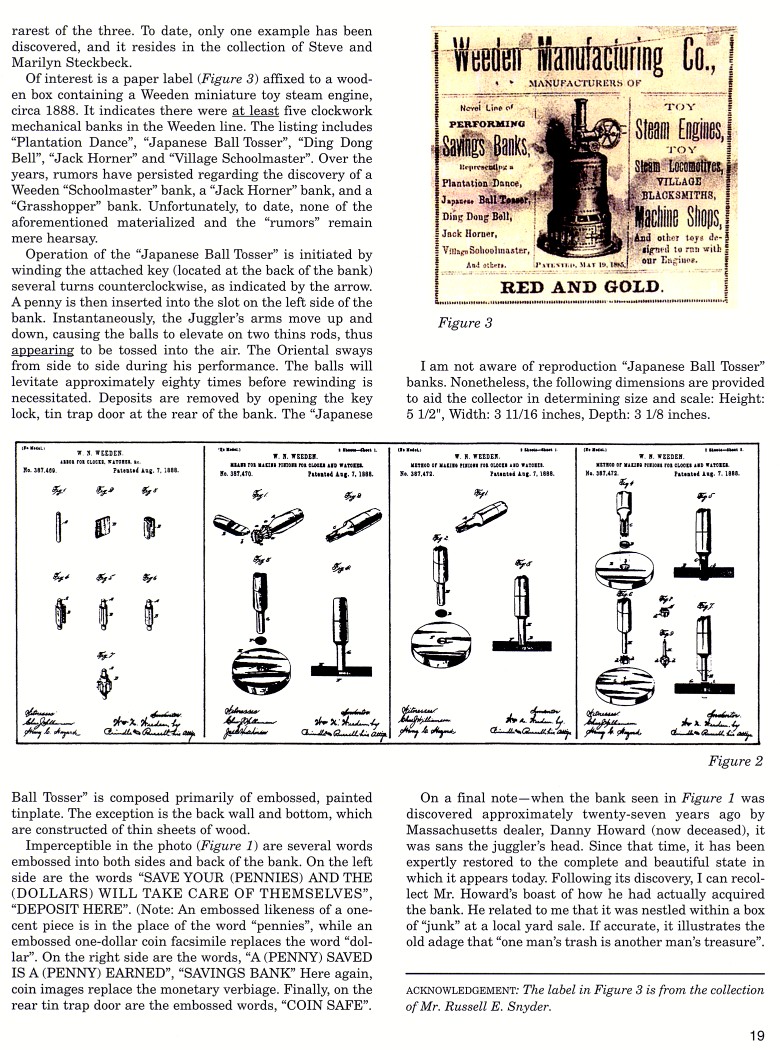|
Japanese Ball Tosser
by Sy Schreckinger – ANTIQUE TOY WORLD Magazine – April, 2000
The intrigue, mystery and magic of the Orient has always
fascinated the world outside its boundaries. Unfortunately, suspicion,
fear, and prejudice all too often accompanied this fascination.
A vivid example is the disdain and hostility that greeted multitudes
of Chinese and Japanese immigrants during the latter portion of the
nineteenth century. These ill feelings became widespread and were
communicated via art and literature, as well as various products popular
to the era. Included amongst the latter were children's playthings such as
mechanical banks. Several depicted the new arrivals as deceitful,
repulsive beings, worthy of ridicule. Examples included: "Reclining
Chinaman" (refer to Antique Toy World,
April 1983), "Chinaman in the Boat"
(June 1999), "Mikado Bank" (December 1996), "Coolie Bank", "Mandarin
Bank", and "Japanese Ball Tosser" (Figure 1).
The "Japanese Ball Tosser" Bank was invented and patented by William
T. Weeden of New Bedford, Massachusetts. It was manufactured by his
company circa 1888. Interestingly, the patents (Figure 2) assigned to the
entire line of Weeden mechanical banks protect only the internal gears and
pinions, including their manufacturing process. There is absolutely no
mention of the bank's action, external appearance, subject, or design.
An early Charles Schmidt Toy and Notion Company catalog dated October
1, 1888, pictures the "Japanese Ball Tosser" Bank with a selling price of
$9.00 per dozen. This date of sale and price appear to correspond with the
date of manufacture of other Weeden clockwork mechanical banks in the
series, i.e. "Plantation Darkey Bank" and "Ding Dong Bell". Of the three,
however, the "Plantation Darkey" is considered the more common, since a
greater number of examples are known to exist. The "Ding Dong Bell" is far
more scarce, with less than a handful in collections. The "Japanese Ball
Tosser" (Figure 1) is the rarest of the three. To date, only one example
has been discovered, and it resides in the collection of Steve and Marilyn
Steckbeck.
Of interest is a paper label (Figure 3) affixed to a wooden box
containing a Weeden miniature toy steam engine, circa 1888. It indicates
there were at least five clockwork mechanical banks in the Weeden line.
The listing includes "Plantation Dance", "Japanese Ball Tosser", "Ding
Dong Bell", "Jack Horner" and "Village Schoolmaster". Over the years,
rumors have persisted regarding the discovery of a Weeden "Schoolmaster"
bank, a "Jack Horner" bank, and a "Grasshopper" bank. Unfortunately, to
date, none of the aforementioned materialized and the "rumors" remain mere
hearsay.
Operation of the "Japanese Ball Tosser" is initiated by winding the
attached key (located at the back of the bank) several turns
counterclockwise, as indicated by the arrow. A penny is then inserted into
the slot on the left side of the bank. Instantaneously, the Juggler's arms
move up and down, causing the balls to elevate on two thins rods, thus
appearing to be tossed into the air. The Oriental sways from side to side
during his performance. The balls will levitate approximately eighty times
before rewinding is necessitated. Deposits are removed by opening the key
lock, tin trap door at the rear of the bank. The "Japanese Ball Tosser" is
composed primarily of embossed, painted tinplate. The exception is the
back wall and bottom, which are constructed of thin sheets of wood.
Imperceptible in the photo (Figure 1) are several words embossed into
both sides and back of the bank. On the left side are the words "SAVE YOUR
(PENNIES) AND THE (DOLLARS) WILL TAKE CARE OF THEMSELVES", "DEPOSIT HERE".
(Note: An embossed likeness of a one- cent piece is in the place of the
word "pennies", while an embossed one-dollar coin facsimile replaces the
word "dollar". On the right side are the words, "A (PENNY) SAVED IS A
(PENNY) EARNED", "SAVINGS BANK" Here again, coin images replace the
monetary verbiage. Finally, on the rear tin trap door are the embossed
words, "COIN SAFE".
I am not aware of reproduction "Japanese Ball Tosser" banks.
Nonetheless, the following dimensions are provided to aid the collector in
determining size and scale: Height: 5-1/2", Width: 3-11/16 inches, Depth:
3-1/8 inches.
On a final note — when the bank seen in Figure 1 was discovered
approximately twenty-seven years ago by Massachusetts dealer, Danny Howard
(now deceased), it was sans the juggler's head. Since that time, it has
been expertly restored to the complete and beautiful state in which it
appears today. Following its discovery, I can recollect Mr. Howard's boast
of how he had actually acquired the bank. He related to me that it was
nestled within a box of "junk" at a local yard sale. If accurate, it
illustrates the old adage that "one man's trash is another man's
treasure".
ACKNOWLEDGEMENT: The label in Figure 3 is from the collection of Mr.
Russell E. Snyder.
|

